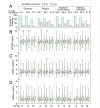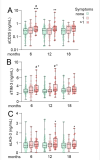Markers of T cell activation and exhaustion in plasma are associated with persistent symptoms up to 18 months following mild SARS-CoV-2 infection
Thor Ueland, Rebecca Jane Cox, Annika E. Michelsen, Elisabeth Berg Fjelltveit, Kari Otterdal, Tuva Dahl, Fan Zhou, Rebecca Elyanow, Pål Aukrust, Bjørn Blomberg, Bente E. Halvorsen, Nina Langeland
[Line breaks added]
Background
Persistent symptoms following SARS-CoV-2 is an increasing problem after COVID-19 disease. The pathogenesis of this persistent post Covid-19 Condition (PCC) is, however, largely unknown. We hypothesized that persistent T cell activation and exhaustion play a role in PCC development.
Methods
We examined plasma levels of soluble (s) CD25, TIM-3 and LAG-3, all markers of T cell activation/exhaustion, by enzyme immunoassays in 170 home-isolated and 53 hospitalized patients for up to 18 months after COVID-19 in relation to persistent symptomatology.
Results
Our major findings were:
(i) Cases with persistent dyspnea and fatigue had markedly higher sCD25 at 6–18 months with a more modest increase in sTIM-3.
(ii) Cases with memory problems at 12–18 months had increased sLAG-3
iii) sCD25 correlated with SARS-CoV-2 antibody titers and microneutralization titers only in cases with PCC while sTIM-3 correlated with these parameters irrespectively of symptoms.
iv) Although hospitalized patients had markedly elevated levels of T cell activation/exhausting markers during follow-up, there was no relation to PCC symptoms.
Conclusion
Our study indicates a role for T cell activation/exhaustion in PCC following home isolated COVID-19 infection, with somewhat different patterns of sCD25, sTIM-3 and sLAG-3, but not in hospitalized COVID-19 patients where disease severity may be more important.
Link | PDF (Front. Immunol.) [Open Access]
Thor Ueland, Rebecca Jane Cox, Annika E. Michelsen, Elisabeth Berg Fjelltveit, Kari Otterdal, Tuva Dahl, Fan Zhou, Rebecca Elyanow, Pål Aukrust, Bjørn Blomberg, Bente E. Halvorsen, Nina Langeland
[Line breaks added]
Background
Persistent symptoms following SARS-CoV-2 is an increasing problem after COVID-19 disease. The pathogenesis of this persistent post Covid-19 Condition (PCC) is, however, largely unknown. We hypothesized that persistent T cell activation and exhaustion play a role in PCC development.
Methods
We examined plasma levels of soluble (s) CD25, TIM-3 and LAG-3, all markers of T cell activation/exhaustion, by enzyme immunoassays in 170 home-isolated and 53 hospitalized patients for up to 18 months after COVID-19 in relation to persistent symptomatology.
Results
Our major findings were:
(i) Cases with persistent dyspnea and fatigue had markedly higher sCD25 at 6–18 months with a more modest increase in sTIM-3.
(ii) Cases with memory problems at 12–18 months had increased sLAG-3
iii) sCD25 correlated with SARS-CoV-2 antibody titers and microneutralization titers only in cases with PCC while sTIM-3 correlated with these parameters irrespectively of symptoms.
iv) Although hospitalized patients had markedly elevated levels of T cell activation/exhausting markers during follow-up, there was no relation to PCC symptoms.
Conclusion
Our study indicates a role for T cell activation/exhaustion in PCC following home isolated COVID-19 infection, with somewhat different patterns of sCD25, sTIM-3 and sLAG-3, but not in hospitalized COVID-19 patients where disease severity may be more important.
Link | PDF (Front. Immunol.) [Open Access]


